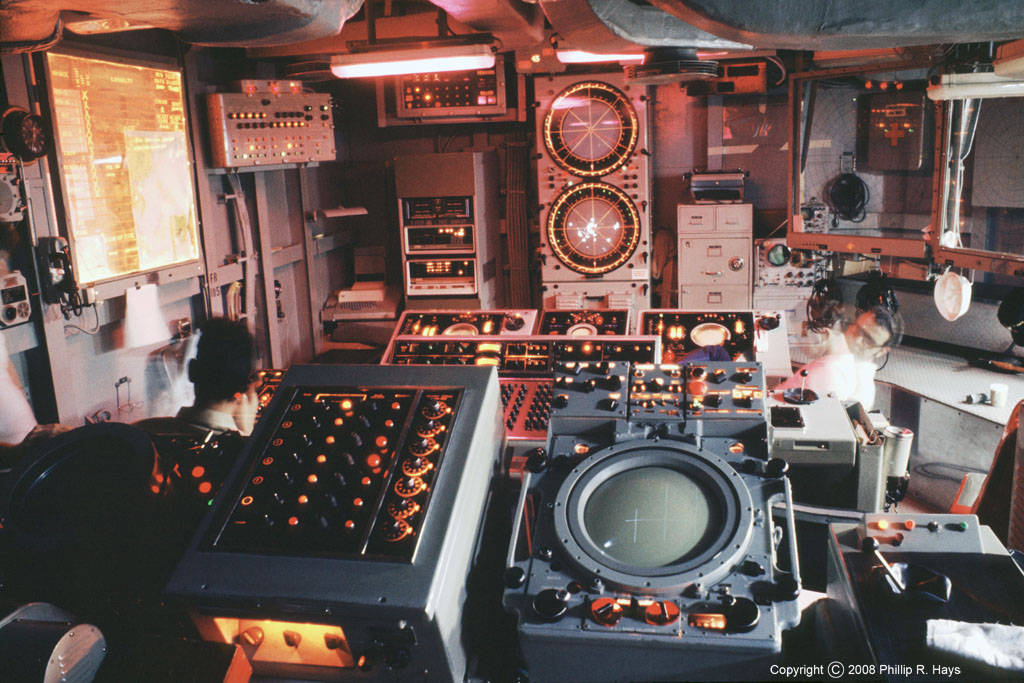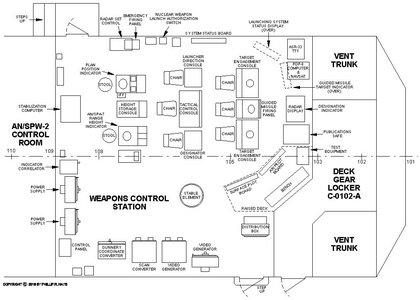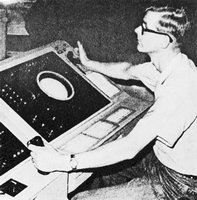

Weapons Control was the Talos missile battery control center where targets were selected, tracked and engaged with Talos guided missiles. It was located on the O2 level in the superstructure on top of the missile house. Weapons Control was manned during General Quarters and Condition II AAW when there was a threat of enemy air attack.
At the front of Weapons Control were two large vertically mounted circular radar display monitors (Designation Indicators), one above the other, about the size of a twin front loading washer/dryer combination. To the left of the displays was a PDP-8 minicomputer and a NAVSAT receiver that gave us position information every 90 minutes from the Navy's NAVSTAR satellite system - an early "GPS." Displays at the front of Weapons Control above the computer showed information about the launching system and how each target "raid" was being engaged (missiles carrying one conventional warhead, two conventional warheads or one nuclear warhead). To the right of the radar displays were lighted Plexiglas panels where the relative positions of surface and air targets reported by CIC (Combat Information Center) were plotted with yellow grease pencils.

In front of the Designation Indicators was a row of three consoles. In the center was the Guided Missile Firing Panel. It had a SPS-10 surface search radar display to show any friendly ships in the area. The missile launch control trigger was on this console. On either side of the launcher console was a Target Engagement Console, one for each of the SPG-49 tracking radars.
In the second row of consoles was the Tactical Control Console for the Mk 7 Guided Missile Launching System. This had an array of lights showing the status of missiles in the Ready Service Magazine, Wing and Fin Area and on the Launcher. The operator could push buttons to select which missile he wanted to fire and the Area 2 Ready Service Magazine would rotate and place the selected missile on the launcher rails. The missile was moved into the Wing and Fin Area where wings and fins were installed, and then it was moved to the Mk 7 Missile Launcher. Other launching system consoles flanked the Tactical Control Console.
A third row of consoles contained a Plan Position Indicator radar repeater, a SPA-7 Range Height Indicator radar repeater, and a target height designation console. This allowed the Weapons Control Officer to select targets for tracking (up to six at a time) and which to engage immediately (only two at a time). The radar repeater was normally set to the SPS-43 air search radar and the height radar repeater was set to the SPS-30 3D altitude determination radar.
On the left side of the space was a lighted Plexiglas panel where equipment status was reported. The Emergency Firing Panel controlled the Emergency Igniter on the Mk 7 missile Launcher that was used to ignite a Talos booster if the normal firing circuits failed. Below this was the Nuclear Weapon Launch Authorization switch. It was a standard "T" handle switch with two positions - "GO" and "NO GO." The Captain had the key for the box that enclosed the switch and he gave it to the Weapons Officer to authorize a nuclear armed missile launch. There was another switch just like it on the Launcher Control Panel two decks below in the Wing and Fin Area in the missile house. To authorize a nuclear missile launch both switches had to be rotated to the "GO" position at the same time. The Captain on the Bridge gave the order to initiate nuclear weapons launches.
The remainder of the space in Weapons Control was filled with various computers, radar controls, power supplies, ship's interior communications equipment, display generators for all the consoles, and the Stable Element. The Stable Element was positioned above the launching system and below the SPG-49 tracking radars. It was a gyroscope that sensed the motion of the launching system and fed this information to the Mk 111 Guided Missile Computer. The computer generated corrections to the positions of the SPG-49 target tacking radars, the SPW-2 missile guidance transmitters and the missile Launcher. This kept everything pointing in the right direction as the ship pitched, rolled and changed course and speed.
Aerial Target Engagement
The process of engaging an aircraft or missile target with the Talos missile system started in CIC. Contacts discovered with the SPS-43 air search radar were evaluated as to the type and threat each represented. The SPS-43 could track high altitude targets at a range of 300 miles. CIC had radar repeaters with lighted plotting heads and television cameras mounted above them. Operators used grease pencils to mark target positions on the plotting heads to select targets for the missile system. The image of the CIC plotting heads appeared on the large Designation Indicator monitors at the front of Weapons Control.
The missile system could track six targets simultaneously. The Weapons Control operators selected targets sent by CIC by placing a cursor over the target on the radar display and pressing a button to assign the target to one of six "channels" in the missile target tracking system. Range and bearing information for each target was stored in the channels. The SPA-7 operator would direct the SPS-30 height finding radar to track a target and then use the Height Storage Console to assign an altitude for targets in each channel. The system then generated tracking symbols for each of the six channels and displayed this information on the large Designation Indicator monitors.
Talos missiles had a range of 130 nautical miles (150 land miles). The Weapons Control Officer decided which targets were the greatest threat likely to come in range of the Talos missiles. One of the SPG-49 missile tracking radars was assigned to acquire and track a "raid" using a Target Engagement Console. The operator used a joystick to move a cursor over the desired target image on the Designation Indicator monitors and pressed a button to assign the associated SPG-49 to track that target. This gave the Mk 111 missile computer the range, bearing, altitude and course of each of the targets. The computer then steered the SPG-49 antenna to the target and started tracking it. There were two SPG-49 radars and two SPW-2 missile guidance systems, so two raids could be engaged at the same time. A target could also be assigned to the Gun Battery. For this the Mk 37 Gun Director was assigned to track the target. The bearing, range and altitude information went to the Mk 1A Gunfire Control Computer in the Double Purpose Battery Plot Room to control the Director to track the target.
After the Mk 111 missile computer determined an intercept solution the Mk 7 Guided Missile Launching System could be assigned to engage the target. The Weapons Control Officer decided which of the two targets that were being tracked by the SPG-49s was the greatest threat and assigned the launcher to that target first. A particular missile (or two) from the Ready Service Magazine was chosen to engage the target using the Tactical Control Console, depending upon the warhead type (conventional or nuclear) appropriate to destroy the target. Nuclear warheads could be used to destroy multiple aircraft targets with a single missile. Normally two conventionally armed missiles were used to engage a target. The Mk 7 Guided Missile Launching System automatically placed the selected missiles on the launcher rail and sent them to Area I Wing and Fin. There the wings and fins were installed on the missiles and they were moved to the Mk 7 Missile Launcher.
While this was happening the Guided Missile Firing Panel operator observed the SPS-10 Surface Search Radar display on his console. The computer generated a circle cursor to show the probable area of impact of the missile booster after it was spent. If a friendly ship was within the impact area the operator used a joystick to change the angle of the launcher so the booster would fall in a safe area - a thousand pound Mach 2 booster would make a nasty hole in anything it hit. The Mk 111 computer then generated a new launch and guidance angle for the missile Launcher and the SPW-2 guidance system. The missiles had a short warm up time on the launcher to allow the internal gyros to stabilize. When the Mk 111 computer signalled that the target intercept point was within range and the missiles were ready for launch the Guided Missile Firing Panel operator pulled the trigger to fire the missiles. They were automatically fired one after the other with a one second interval.
The Mk 111 computer controlled the SPG-49 tracking radar to continue to receive target tracking information. The computer also controlled the SPW-2 guidance system that directed the missiles to the intercept point. The missiles replied to the guidance signals to provide the computer with tracking information for the missile. When missiles with conventional warheads approached the target the computer caused the SPG-49 to send illumination signals to reflect off the target for the missiles to home on. A few seconds before intercept the computer commanded the missiles to dive on the target from above. It took about two seconds for the missiles to acquire the target. Diving on the target from above provided the largest possible intercept signal. The large expanding rod warhead had a long lethal range, so the missiles rarely failed to damage or destroy the target.
A nuclear armed missile was guided to the area of multiple targets and commanded to detonate using the SPW-2 guidance signal. It did not home on any particular target.
After the raid was destroyed the channel in the tracking system was released to track another target, and another target channel could be selected for intercept and assigned to the SPG-49 to start the process over again.
Surface to Surface Anti-ship Engagement
Surface targets (ships) were engaged in a similar manner to aerial targets. The only difference is that CIC used information from the Electronics Counter Measures operators or the SPS-10 Surface Search Radar to determine the initial range and bearing to the target. After the SPG-49 tracking radar succeeded in acquiring the target a missile was launched. The missile climbed high and arced over to descend on the target from above. Surface target engagement depended upon the missiles seeing a reflected SPG-49 signal from the target, and Earth's curvature limited the range. However, the missiles could engage surface targets over the horizon out to a range of about 40 nautical miles, and were able to distinguish ship targets from background reflections from waves and swells.
Shore Installation Engagement
Shore targets could be engaged with nuclear armed Talos missiles. The process was very different from conventionally armed missile shots. First the ship's geographical position was determined from the NAVSAT receiver and fed into the PDP-8 computer. Then the geographic position of the target was entered into the computer. The computer calculated a trajectory for the missile from the ship to the target.
The nuclear armed missile was loaded onto the launcher. When the Captain ordered the missile to be launched it was fired from the Guided Missile Firing Panel. The computer guided the missile to the target with the SPW-2 guidance system. When it arrived at the target the missile was commanded to dive and the warhead was detonated with a signal from the computer when it attained the optimal altitude to cause the maximum amount of damage to the target. The effective range for nuclear shots was determined by the desired burst height altitude and Earth's curvature. The missile had to be able to receive the line of sight detonation command signal from the ship.
Anti-radiation (Radar) Target Engagement
The Talos RIM-8H missile had an anti-radiation capability (ARM) to attack enemy radar installations. The electronics Warfare watch in the CIC ECM Area searched for signals from enemy radars. When a radar was detected the bearing, frequency and pulse rate of the signal was determined. This information was passed to the Mk 111 missile computer. When the ARM missile was warming up on the launcher rail the specific radar signal characteristics were programmed into the missile.
The missile was launched with the trigger on the Guided Missile Firing Panel. The missile was guided to the vicinity of the target by the computer using the SPW-2 guidance system. When near the target the missile was commanded to search for the programmed radar signal. When the missile acquired the programmed signal it flew to a position over the target and dived on it from above, homing on the radar signal. If the radar remained active the missile could not miss. Even if the operators shut down the radar, the electronics would continue to emit some radiation until the transmitters cooled down, and the missile could still home on that weak signal. The only way to stop all emissions immediately was to interrupt the radar antenna's wave guide path with a mechanical wave guide switch.
The USS Oklahoma City CLG-5 was the first ship in US Navy history to fire a successful surface-to-surface missile shot in combat, and the first ship to fire a successful ARM missile shot in combat. The personnel on watch during that shot were awarded the Navy Achievement Medal.
